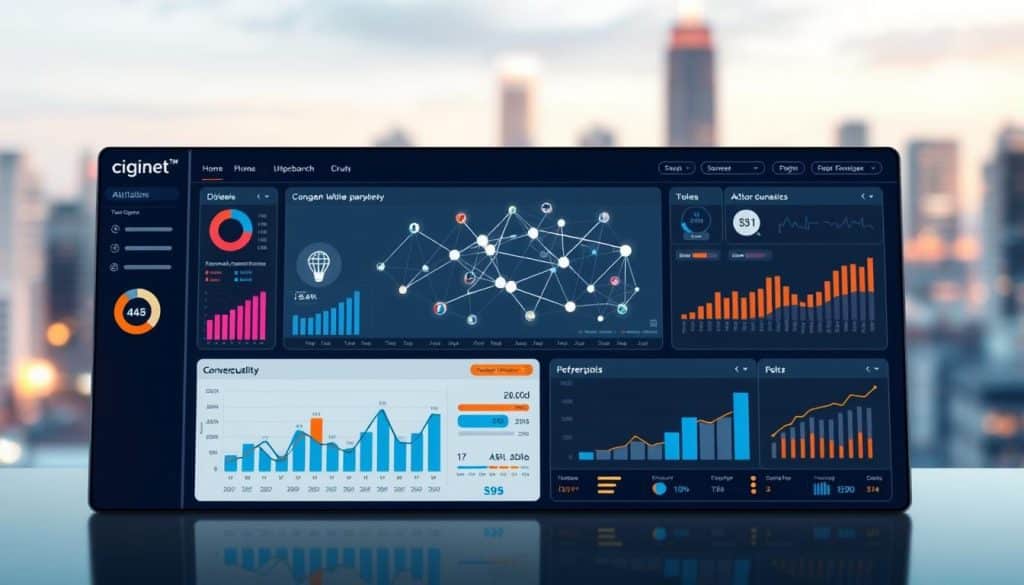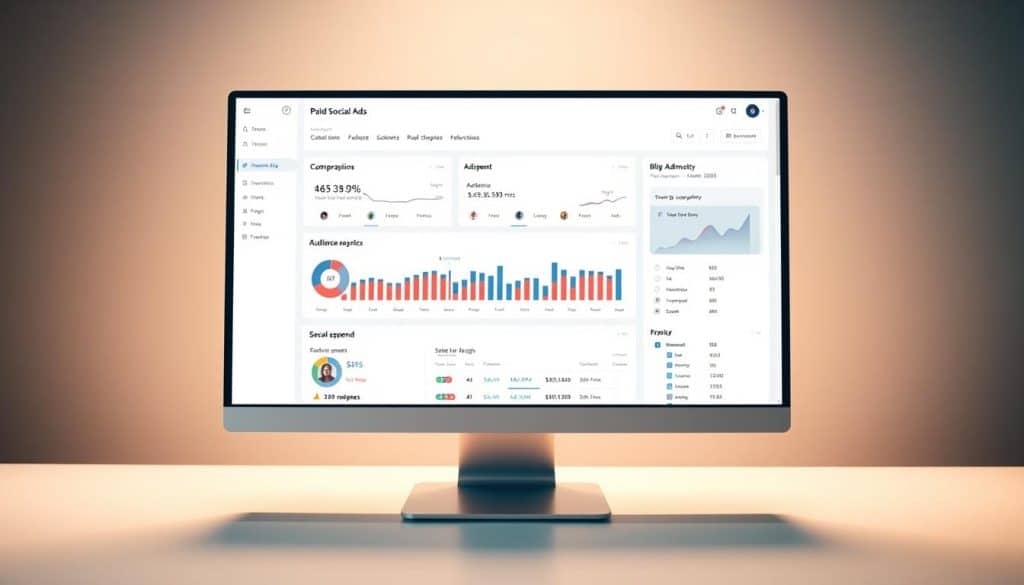Ever wondered why some websites get lots of visitors while others don’t? The secret is web design and SEO working together. They make a website that looks great and ranks well in search results.
A good website is like your business’s online store. It’s where people first see you and can connect with you. But, a beautiful site won’t help if no one finds it. That’s where SEO comes in, making your site easy to find.

Most online experiences start with a search engine. And 75% of users only look at the first page of results. This shows how important it is to have a website that’s easy to find and use.
It’s not just about being seen; it’s about making a good impression. Fast websites rank better, and pages that load quickly keep users interested. Pages that load in 2 seconds have a 9% bounce rate, compared to 38% for slower pages.
As we explore web design and SEO together, we’ll see how they make a strong online presence. This presence not only draws in visitors but also turns them into loyal customers.
Key Takeaways
- Web design and SEO work together to enhance online visibility and user experience
- 93% of online experiences start with a search engine
- 75% of users don’t go beyond the first page of search results
- Optimized websites can improve high-quality leads by 50%
- Fast-loading pages (2 seconds) have a significantly lower bounce rate (9%) compared to slower pages
- Integrating SEO into web design from the start sets the foundation for online success
Understanding the Symbiotic Relationship Between Web Design and SEO
Web design and SEO work together like two hands. A good website looks great and helps with search rankings. Let’s explore how they combine for a strong online presence.
The Role of User Experience in Modern SEO
User experience (UX) is key in today’s SEO. A good UX keeps people coming back. In fact, 88% of users are less likely to return after a bad experience.
This impacts bounce rates and how long people stay on the site. Both are important for search rankings.
How Design Elements Impact Search Rankings
Design choices affect SEO. Page speed is critical – a 1-second delay can drop conversions by 7%. Mobile responsiveness is also key, as Google now uses mobile-first indexing.
The Value of Visual Communication in Digital Marketing
Visual elements are crucial for engaging users and boosting SEO. A clean design can increase user engagement by 50%. Also, 75% of users judge a company’s credibility by its website design.
By combining strong design with SEO, businesses can make websites that rank well and offer value. This mix of design and SEO is vital for lasting online success.
Essential Technical SEO Elements in Web Design
Web design and SEO are key to a strong online presence. A well-designed site looks great and ranks well in search engines. Let’s look at important technical SEO elements for your web design.
Mobile Responsiveness and Its Impact
Today, mobile-friendly sites are a must. Over 55% of website traffic comes from mobiles, and 92.3% of users access the web on phones. Search engines now favor mobile-responsive sites.
A responsive design works well on all screen sizes. This improves user experience and boosts search rankings. Sites with responsive design rank higher in search results.
Page Load Speed Optimization
Speed is crucial online. Slow sites lead to high bounce rates and lower rankings. Slow load times can also cause cart abandonment for e-commerce sites.
To speed up your site:
- Compress images without losing quality
- Minimize HTTP requests
- Enable browser caching
- Use a content delivery network (CDN)
Clean URL Structure Implementation
Clean, readable URLs are vital for SEO. Search engines use keywords in URLs to match content with search queries. A clean URL structure helps both search engines and users quickly understand your page content.
| Poor URL Structure | Clean URL Structure |
|---|---|
| example.com/page.php?id=123 | example.com/seo-friendly-urls |
| example.com/category/subcategory/product-12345 | example.com/category/product-name |
Adding these technical SEO elements to your website can improve rankings, user experience, and conversions. A strong website design and SEO strategy can increase leads by 250%. Focus on these during your next SEO technical audit to boost your online presence and success.
Optimizing Website Navigation for SEO Success
Smart navigation is crucial for a good website. A clear menu lets visitors find what they need fast, which keeps them engaged. By limiting main menu options and grouping items logically, you make it easy for users.
In our experience, website optimization is the key to merging great web design with effective SEO. We focus on creating fast, mobile-friendly, and user-centric sites that not only rank higher on search engines but also provide a seamless experience for visitors. It’s the perfect balance of design and functionality.
Good navigation also lowers bounce rates and encourages users to explore more. This tells search engines your site is valuable, which can increase organic search traffic by 15%. Adding breadcrumbs helps users see where they are, making the site easier to use.
- Keep main menu items to a minimum
- Use descriptive labels for menu items
- Include a search function for large sites
- Ensure mobile-friendly navigation
Now, about 55% of internet traffic comes from mobile devices. Having a responsive design is key, as it can boost organic search traffic by 15%. A site that works well on mobile and has easy navigation can greatly improve your SEO.
Also, 94% of first impressions are about design. By combining smart navigation with SEO, you’re ready for better user engagement and higher search rankings. Spend time making your website’s design and navigation better. It’s a proven way to increase your online visibility and credibility.
Combining Web Design and SEO for Maximum Online Visibility
Web design and SEO work together to boost online visibility. A well-designed website looks good and ranks well in search engines. Digital marketing agencies aim to create sites that are both beautiful and search engine friendly.
Using effective search engine optimization techniques is essential for improving your website’s visibility. By targeting the right keywords, optimizing meta tags, and ensuring a fast, mobile-friendly experience, you can enhance your rankings and attract the audience that matters most to your business.
Creating Search Engine Friendly Layouts
Search engine friendly layouts are key for visibility. Websites with optimized layouts see a 50% increase in user engagement. This leads to higher conversion rates and better search rankings. A clean design helps search engines crawl and index content better.
Implementing Effective Content Hierarchy
Content hierarchy is vital for both user experience and SEO. Properly structured headings (H1, H2, etc.) make content easier to read and SEO-friendly. This structure helps search engines understand content importance. Businesses that focus on design see a 1.5 times increase in their bottom line.
Balancing Aesthetics with SEO Requirements
Balancing design with SEO is an art that digital marketing agencies master. They use keywords naturally in design and content. This ensures websites are both beautiful and optimized for search engines. A well-designed website can also lower bounce rates, which means fewer visitors leave after viewing just one page.
| Design Element | SEO Impact | User Experience Impact |
|---|---|---|
| Responsive Design | Improves mobile rankings | Enhances mobile usability |
| Fast Load Times | Boosts search rankings | Reduces bounce rates |
| Clear Navigation | Aids site indexing | Improves user journey |
By combining web design with SEO, businesses can greatly improve their online presence. This approach not only boosts search rankings but also enhances user experience. This leads to higher conversion rates and business growth.
Image Optimization and Visual Content Strategy
Visual content is key to better user experience and SEO. Search engines now show text, images, and videos in their results. This changes how we think about SEO. Let’s look at how to make images better and create a winning visual content plan.
Alt Text Best Practices
Alt text is important for both accessibility and SEO. It helps search engines understand what images are about. Use clear, keyword-rich alt text that matches the image. Make sure alt text works well on all devices for responsive web design images.
Image Compression Techniques
Fast loading times are crucial for user experience and SEO. Big images can slow down websites. Use compression to make images smaller without losing quality. This is key for responsive web design images to load quickly on all devices.
Visual Content Placement for SEO
Where you place visual content matters a lot. A Massachusetts Resort and Spa saw a huge jump in visual search performance. Use interactive videos, like 360-degree views, to keep users engaged and improve rankings.
| Visual Content Type | SEO Impact | User Experience Enhancement |
|---|---|---|
| Responsive Images | Improved mobile rankings | Consistent viewing across devices |
| Infographics | Increased backlinks | Enhanced information retention |
| Short-form Videos | Higher SERP visibility | Increased engagement |
By using these strategies, businesses can make their visual content more impactful. Regular updates and checks on performance are vital. This helps use traffic and engagement insights to improve strategies.
Content Architecture and Website Structure
A well-crafted content architecture is key to a great website. It’s not just about organizing info; it’s about making the site easy to use. This leads to more engagement and sales. Sites with good info architecture see a 47% jump in user happiness because it’s easy to navigate.
The way your website is set up is very important. A clear and simple navigation can cut bounce rates by 50% on average. This better user experience also helps your site rank higher in search results, up to 30% better.
When planning your site’s layout, keep it simple. Aim for a structure that lets users find what they need in three clicks. This makes your site easier to use and boosts SEO. Sites with sitemaps get crawled 50% more often by search engines.
Internal linking is also vital for content optimization. Good internal linking can boost a page’s search ranking by 50%. Avoiding orphan pages can cut bounce rates by 25%. This strategy helps spread out link value and guides users and search engines through your site.
Your website’s structure matters to both users and search engines. A clear site hierarchy lets users find what they need 40% faster. And 83% of users say usability and navigation greatly affect their view of a brand.
“A well-structured website is like a well-organized library. It makes finding what you need effortless and enjoyable.”
In short, spending time on a solid content architecture and website structure is worth it. It boosts user satisfaction, SEO, and business success. With the right setup, your site will rank well and offer real value to visitors.
Mobile-First Design Principles for Better Rankings
In today’s digital world, making your site mobile-friendly is key to success. With mobiles making up 54.67% of all website visits in late 2023, it’s clear mobile experience matters a lot.
We always emphasize the importance of knowing how to make your website mobile friendly. It starts with responsive design, ensuring your site adapts seamlessly to any screen size. We also optimize loading speeds, simplify navigation, and test regularly to guarantee a smooth experience for mobile users.
To make your site mobile-friendly and better for users, follow these important principles:
Responsive Design Implementation
Responsive design makes your site work well on all devices. Google says this is the best way because it’s easy to keep up. It means your site looks the same on all devices, giving users a consistent experience.
Mobile Performance Optimization
Speed is key for mobile users. A big 53% of visitors leave if a site takes more than three seconds to load. To speed up your site:
- Keep your code simple and use browser caching
- Shrink images without losing quality
- Use Accelerated Mobile Pages (AMP) when you can
Here are some speed goals to aim for:
- Largest Contentful Paint (LCP): 2.5 seconds or less
- Interaction to Next Paint (INP): 200 milliseconds or less
- Cumulative Layout Shift (CLS): 0.1 or lower
Touch-Friendly Interface Design
Make your mobile site easy to use with these tips:
- Make buttons big enough to tap easily
- Leave enough space between things you can click
- Add mobile-only features like call buttons
- Use location services to make your site more relevant
By focusing on these mobile-first design tips, you’ll boost your site’s rankings and user experience. Remember, Google looks at your mobile site first, so it’s key for search visibility. With mobile searches leading to clicks 65.6% of the time, making your site mobile-friendly is a smart move.
Technical Performance and User Experience Metrics
In today’s digital world, website analytics and user experience are key to success online. A well-designed site attracts and keeps visitors, boosting time spent and search rankings.
Improving user experience can lead to big wins. Virgin America, for example, saw a 14% increase in sales after focusing on user needs. They also cut customer service calls by 20%. These changes show the real value of putting users first.
In e-commerce, knowing how users behave is vital. Common reasons for cart abandonment include extra costs, needing to create an account, and slow delivery. Fixing these issues can greatly improve sales.
Investing in user experience is essential, not just a luxury. Experts suggest spending at least 10% of a project’s budget on UX design. Successful projects may spend up to 40%. This investment can significantly improve site performance and user happiness.
The link between user experience and SEO is clear. Sites that focus on user experience can see a 50% or more increase in conversions. Mobile-optimized sites can see a 60% boost in traffic from better search rankings. These numbers highlight the need to design sites that meet both user and search engine needs.
To get the most from user experience and website analytics, track important metrics like page load speed, bounce rate, and time on page. Aim for page loads under 2.5 seconds to keep users happy. Also, make sure your site’s structure is easy to navigate, with subpages reachable in four clicks from the homepage. By always improving these areas, you can build a site that ranks well and provides value to visitors.
Building Trust Through Professional Web Design
A professional web design is key to gaining trust from your audience. Studies show that 75% of users judge a company’s credibility by its website. A good design is essential for building confidence in your brand.
Brand Consistency Elements
Keeping your brand consistent is vital for trust. Use the same colors, fonts, and design elements across your site. A web design company should aim to create a site that matches your brand values and appeals to your audience.
Trust Signals Implementation
Trust signals are crucial for credibility. These include:
- Security badges
- Customer testimonials
- Clear contact information
- Industry certifications
- Awards and partnerships
Showing these elements well on your site can greatly affect how users see you. About 88% of users are less likely to return after a bad experience.
A trustworthy design leads to more engagement and lower bounce rates. Sites with good design see up to 400% more conversions. This not only helps visitors but also improves your site’s ranking.
| Trust Signal | Impact on User Perception |
|---|---|
| Security Badges | Increases sense of safety in transactions |
| Customer Testimonials | Builds social proof and credibility |
| Clear Contact Information | Enhances transparency and accessibility |
| Industry Certifications | Demonstrates expertise and qualifications |
| Awards and Partnerships | Showcases recognition and reliability |
By focusing on trust-building elements, a web design company can attract and convert visitors into loyal customers. A well-designed website is an investment in your brand’s credibility and success.
Analytics and Performance Tracking Integration
It’s important to link website analytics with the best keyword research tools. This helps businesses understand their online presence better. With data-driven insights, they can make smart choices to increase visibility and engagement.
Key Performance Indicators
Choosing the right KPIs is key to measuring success. Companies that mix SEO and SEM see better online visibility, traffic, and conversion rates. Look at organic traffic growth, bounce rates, and conversion rates to see how your site is doing.
User Behavior Analysis
Knowing how visitors use your site is crucial for a better user experience. Heatmaps and user journey analysis show how users interact, helping you make design changes. This data helps spot issues and improve your site’s engagement.
Conversion Rate Optimization
Testing your site regularly is essential for better performance. Companies with good retargeting see a 10% to over 50% increase in conversions. Use A/B testing to tweak your design and content based on real data.
| Analytics Tool | Primary Function | Key Benefit |
|---|---|---|
| Google Analytics | Comprehensive website data | In-depth user behavior insights |
| Google Search Console | Search performance tracking | SEO optimization opportunities |
| Hotjar | Heatmaps and session recordings | Visual user interaction data |
By using these analytics tools and keyword research tools, you get valuable insights. Real-time monitoring tools give quick info on traffic changes, helping you adjust your SEO strategy fast. This approach leads to ongoing improvement and better online presence.
Conclusion
Web design and SEO are now a must for online success. A fast, easy-to-use website boosts engagement. Sites that load quickly see a 32% higher engagement rate and a 25% lower bounce rate.
Mobile optimization is key, as over 50% of web traffic comes from mobiles. Responsive design can boost mobile traffic by 21% and cut bounce rates by 70%. Good navigation and clear info can improve search rankings by up to 20% and visibility by 40%.
Content is still the most important thing in SEO. Quality content can raise SEO rankings by up to 80% when keywords are used naturally. Businesses that focus on user experience see a 135% increase in conversion rates. By focusing on these areas, businesses can make websites that look good and perform well in search rankings.
Need Help?
Want to unlock the full potential of your online presence? Let us help you combine expert web design and SEO strategies to boost your visibility, drive traffic, and grow your business. Contact us today to create the perfect pairing for your success!
FAQ
Why are both web design and SEO important for online success?
Web design and SEO are key because they work together. A good design makes your site look great and easy to use. SEO helps people find your site when they search for things online. When you combine these, your site gets more visitors.
How does user experience impact SEO?
User experience is now a big deal in SEO. Google looks at how well a site works for users. Things like how fast it loads and how easy it is to use affect your ranking. A good user experience means people stay longer on your site, which is good for SEO.
What are some essential technical SEO elements in web design?
Important technical SEO parts include making your site work well on phones, loading fast, and having clear URLs. Google now looks at mobile sites first. Fast loading is key because people get impatient if a site takes too long. Clear URLs help both search engines and users understand your site better.
How can I optimize website navigation for SEO success?
To improve navigation for SEO, make your site easy to navigate. Use a clear structure and group related topics together. Keep your main menu simple and use breadcrumbs to help users find their way. Good navigation means people are more likely to explore your site, which is good for SEO.
How can I balance aesthetics with SEO requirements in web design?
To mix beauty with SEO, use keywords in your design and content naturally. Make your site easy to optimize with HTML or CSS. Use responsive design so your site looks good on all devices. Use structured headings to make your content easy to read and SEO-friendly. Working with a digital marketing agency can help you do this well.
What are best practices for image optimization in SEO?
For image optimization, name your files clearly and use relevant keywords in alt tags. Compress images to make them smaller without losing quality. This helps your site load faster. Make sure your images are responsive and add value to your content.
How can I implement mobile-first design principles for better rankings?
To focus on mobile design, make your site work well on phones first. Use responsive design to fit different screen sizes. Make your site fast on mobile by using less code and caching. Design your site to be easy to use with your fingers and good spacing.
What metrics should I track for technical performance and user experience?
Watch how fast your site loads, how quickly it starts to show content, and how well it works on phones. For user experience, look at bounce rates, how long people stay, and how many pages they visit. Use tools like Google PageSpeed Insights to find and fix problems. Regularly check your site to make sure it meets SEO standards.
How can web design help build trust with my target audience?
To build trust, keep your site looking consistent with your brand. Use trust signals like security badges and customer testimonials. Show off any awards or partnerships to look credible. A trustworthy site design can lead to more engagement and better rankings.
What are some important analytics and performance tracking tools for SEO and web design?
Use Google Analytics and Google Search Console to see how your site is doing. Track how users interact with your site to find areas to improve. Use tools like heatmaps and session recordings to see what users do. Regularly test different versions of your site to make it better.






